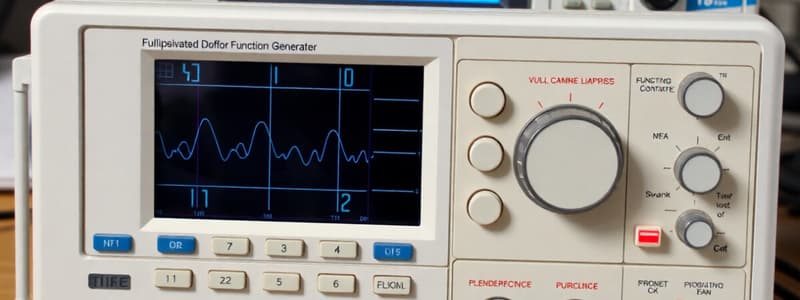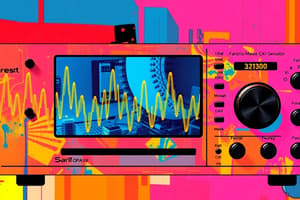Podcast
Questions and Answers
How can you view both channel one and channel two simultaneously on the oscilloscope?
How can you view both channel one and channel two simultaneously on the oscilloscope?
Select the display mode that allows viewing both channels simultaneously.
What is the purpose of setting the zero line to GND for each channel?
What is the purpose of setting the zero line to GND for each channel?
Setting the zero line to GND establishes a reference point for measuring the signals.
What does the adjustment of the horizontal axis (ms/division) influence?
What does the adjustment of the horizontal axis (ms/division) influence?
It influences the time scale of the displayed waveform.
How can you differentiate between AC and DC coupling on an oscilloscope?
How can you differentiate between AC and DC coupling on an oscilloscope?
What is the significance of using a function generator to produce a sine wave and a triangular wave?
What is the significance of using a function generator to produce a sine wave and a triangular wave?
What should you observe while viewing the output of a thermocouple connected to a temperature reader and oscilloscope?
What should you observe while viewing the output of a thermocouple connected to a temperature reader and oscilloscope?
What is the primary function of the intensity and focus controls on an oscilloscope?
What is the primary function of the intensity and focus controls on an oscilloscope?
Why is it important to ensure that the frequency on the oscilloscope matches that of the function generator when observing signals?
Why is it important to ensure that the frequency on the oscilloscope matches that of the function generator when observing signals?
What parameters can you control on a function generator to alter the signals it produces?
What parameters can you control on a function generator to alter the signals it produces?
What is the function of an oscilloscope in the context of signal generation?
What is the function of an oscilloscope in the context of signal generation?
What is the maximum frequency that a function generator can typically produce?
What is the maximum frequency that a function generator can typically produce?
Describe how to combine AC and DC signals using an oscilloscope.
Describe how to combine AC and DC signals using an oscilloscope.
How can you store data from an oscilloscope for later analysis?
How can you store data from an oscilloscope for later analysis?
What precautions should be taken when using a multimeter for measuring voltage?
What precautions should be taken when using a multimeter for measuring voltage?
What are the characteristics of the sine wave function given in Activity #1?
What are the characteristics of the sine wave function given in Activity #1?
What is the significance of adjusting the amplitude on a triangular wave signal in the oscilloscope?
What is the significance of adjusting the amplitude on a triangular wave signal in the oscilloscope?
Flashcards
Function Generator
Function Generator
A device that creates different types of electrical signals, including sine waves, square waves, and triangular waves.
Oscilloscope
Oscilloscope
A device used to display electrical signals graphically, showing waveform over time.
DC offset
DC offset
A constant voltage shift applied to a signal.
Amplitude
Amplitude
Signup and view all the flashcards
Frequency
Frequency
Signup and view all the flashcards
Sine Wave, Square Wave, Triangular Wave
Sine Wave, Square Wave, Triangular Wave
Signup and view all the flashcards
Spectrum Analyzer
Spectrum Analyzer
Signup and view all the flashcards
Multi-meter
Multi-meter
Signup and view all the flashcards
Oscilloscope Channel Selection
Oscilloscope Channel Selection
Signup and view all the flashcards
Oscilloscope Zero Line
Oscilloscope Zero Line
Signup and view all the flashcards
Oscilloscope Timebase
Oscilloscope Timebase
Signup and view all the flashcards
Oscilloscope Vertical Axis Settings
Oscilloscope Vertical Axis Settings
Signup and view all the flashcards
DC Coupling
DC Coupling
Signup and view all the flashcards
AC Coupling
AC Coupling
Signup and view all the flashcards
Function Generator Signal Generation
Function Generator Signal Generation
Signup and view all the flashcards
Signal Sketching
Signal Sketching
Signup and view all the flashcards
Study Notes
Function Generator, Oscilloscope, Power Supply, and Multi-Meter
- Objectives: Generate sine, square, triangular waveforms with adjustable amplitudes, DC offsets, phases, and frequencies.
- Objectives: Adjust oscilloscope settings to view generated functions (single or dual channels, AC/DC coupling).
- Objectives: Use oscilloscope math functions.
- Objectives: Store oscilloscope data to Excel.
- Objectives: Generate DC voltages from the power supply.
- Objectives: View output DC voltages on the oscilloscope.
- Objectives: Effectively use the multi-meter (voltage, current, resistance).
- Objectives: Note precautions for multi-meter measurements.
Function Generator
- Generates sine, square, and triangular waveforms.
- Allows control of amplitude, frequency, phase, and DC offset.
- Used to visualize waveforms with the oscilloscope.
Oscilloscope
- Views signals with time and frequency content.
- Displays output from the function generator and other sources.
- Features dual channels for comparing two signals at once.
- Stores data for analysis, including digital storage capabilities.
DC Power Supply
- Generates various DC voltages.
- Essential to power lab equipment and circuits.
Multi-Meter
- Measures voltage, current, and resistance.
- Crucial for checking circuit components and values.
Specific Activities
- Activity #1: Set a function generator to produce Y = 2 + 0.5sin(200πt) and sketch the signal.
- Activity #2: Set the function generator to a triangular wave (1kHz) and apply a DC offset, sketching the signal.
- Activity #3: Determine the frequency and amplitude range of the function generator.
- Activity #4: Generate sine and triangular waves, viewing them on the oscilloscope, sketching the signals.
- Activity #5: Generate and display Y = 2 + 0.5sin(200πt), using both DC and AC coupling on the oscilloscope.
- Activity #6: Connect a thermocouple to a temperature reader, voltmeter, then oscilloscope and observe the results.
- **Activity #7, #8:**Sketch and note functions of function generator and oscilloscope buttons.
- Activity #9: Generate different voltages using the power supply and measure them with the multimeter.
- Activity #10: View the generated voltages from the power supply on the oscilloscope.
- Activity #11: Sketch the screen of the digital multimeter and identify the function of its buttons.
- Activity #12: Detail precautions for voltage, current, and resistance measurement with a multimeter.
- Activity #13: Download technical manuals for the devices using serial numbers and create a table of specifications.
Studying That Suits You
Use AI to generate personalized quizzes and flashcards to suit your learning preferences.




